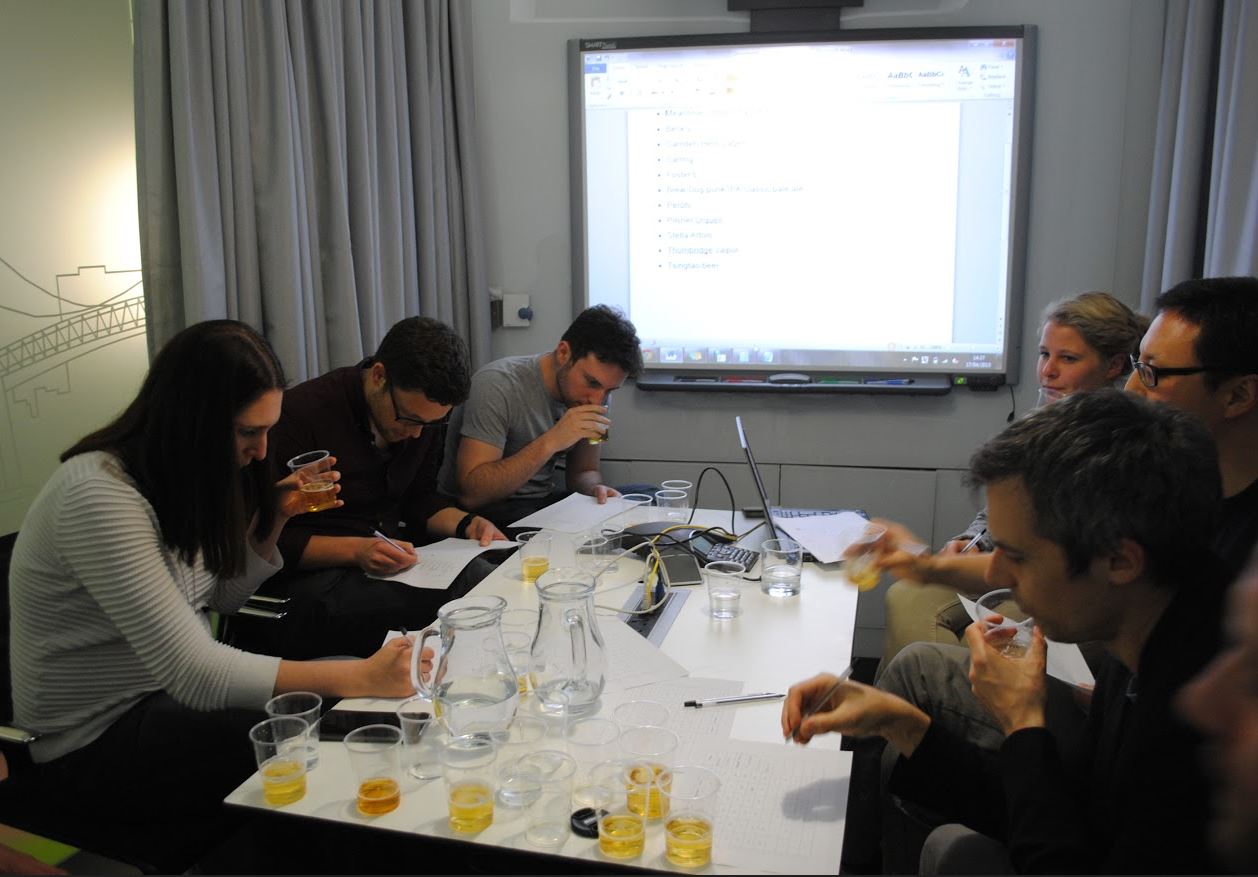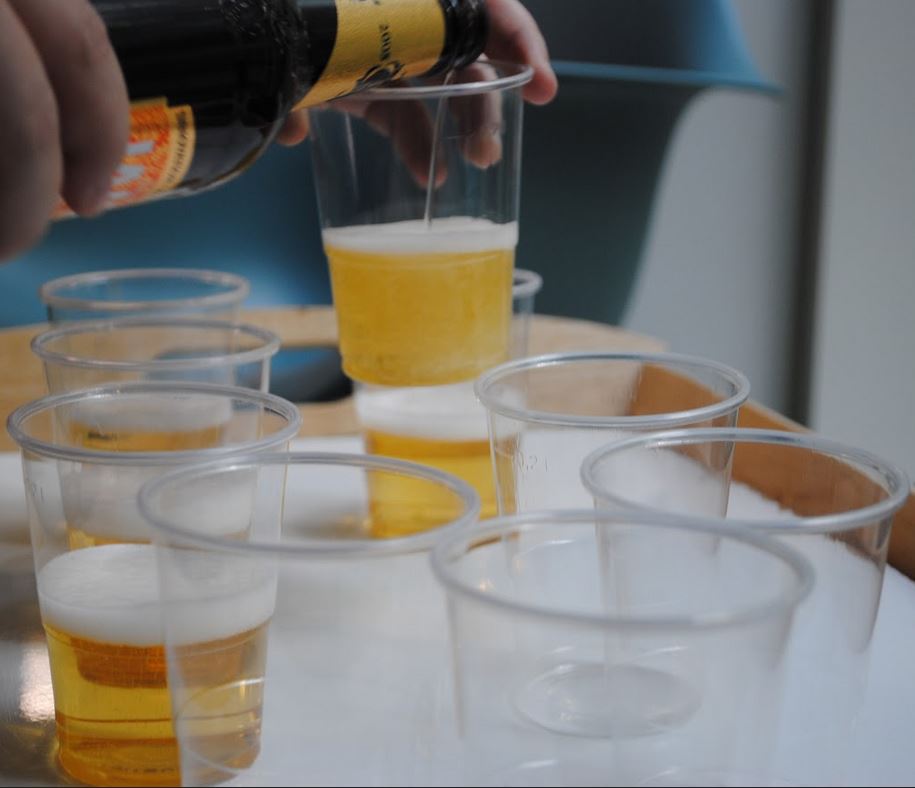-
Articles + –
Just how important is branding in the beer market? Our analysts blind taste and find surprising results
With the surging popularity of craft beer, taste has become of high importance in the beer market. While 34% of beer drinkers are prepared to pay more for craft beers, 59% are only willing to pay more for beer if they can easily taste the difference from cheaper equivalents. Brewers are therefore under pressure to justify any higher prices via a tangible point of difference, for example on taste grounds.
With this in mind, Mintel explored the influence of branding on taste. Some 11 different beers – a mixture of mainstream, craft and ‘global’ brands – were blind-tasted by a panel of 8 sector specialist analysts in Mintel’s London HQ for what was an ad hoc, but insightful, taste test. The beers were marked out of five for: Look/appearance; Aroma; Taste; Palate/mouthfeel and Aftertaste.
Craft v Mainstream
As our analysts moved through the beers, many commented on the lack of flavour differentiation between many brands, which tallies with Mintel’s research that 35% of UK beer drinkers agree it is hard to taste the difference between many beers. With the mainstream beer brands scoring the lowest on overall taste, it’s clear how influential branding is in this sector. One analyst even commented ‘It was a big shock how much I didn’t really like them.’
When it came to craft beer though, the difference was easily distinguished. Four of the top five-scoring brands in our small-scale test are widely considered to be craft, although their significant growth over the past five years arguably moves them beyond this for any volume-based definition. Director of Innovation and Insight David Jago commented, ‘As something of a craft beer enthusiast I wasn’t surprised that the craft pale ales scored highest – the hoppy aroma, stronger flavour, fuller mouthfeel really set those apart.’
Global beers blur the premium lines

When it comes to consumer perception of premium alcohol, drinkers are most likely to cite a full flavour, use of high quality ingredients and extra care/time taken in production as defining. As such, many global and craft beers tick these three boxes, helping to explain their ascent.
 Lower-alcohol drinks struggle to convince
Lower-alcohol drinks struggle to convince
The lowest-scoring beer in our small blind tasting was the non-alcoholic brand. Participants in the tasting noted its lack of aroma and taste, but were unaware at the time of the test that one beer would be alcohol-free. Research Analyst Andre Euphrasio noted, “it was funny to see how disappointed everyone was with the non-alcoholic beer. Everyone knew there was something different about it, although no-one guessed.”
While the low/non-alcoholic beer segment is performing better than the equivalent in wine, its growth in recent years has been fairly modest. Perceived inferiority continues to dampen interest in these variants, with almost half of UK drinkers thinking that lowering the alcohol content of drinks compromises the taste. Meanwhile, ‘bland’ and ‘disappointing’ are the attributes most likely to be associated with lower/non-alcoholic drinks.
While 44% of UK drinkers are interested in lower/non-alcoholic drinks if they are noticeably cheaper than standard variants, taste remains a key consideration. The future growth of the segment will depend on how effectively brands can offset the removal of alcohol by providing interesting/appealing aromas and flavours.
What our analysts thought…

The non-alcoholic beer tasted very chemically but I did not guess for a minute that it was non-alcoholic. I mistook the mainstream beers which position themselves as more premium (in terms of both their price point and branding) for what I expected to be the very generic flavour of ‘mid-market’ brands. It was a big shock how much I didn’t like them. The hops really stood out on the craft ales and made them pretty easy to identify. Meantime was a lot better than I have given the brand credit for.

The difference between the craft beers we tasted and mainstream ones was clear – from the appearance to the taste. I was surprised by Tsingtao, which was my first time trying it and definitely will try again. I can’t say the same about some of the mainstream beers, which, honestly, I drink sometimes. It was funny to see how disappointed everyone was with the non-alcoholic beer. Everyone knew there was something ‘wrong’ with it, although no one guessed.

It seems to me that the big generic brands succeed for a couple of reasons. Firstly, taking the fewest risks to appeal to the broadest demographic and secondly, compensating for lack of flavour identity with a branded one. I don’t generally like lager and prefer ale because of the variations in everything from taste to colour, so I do tend to prefer the craft ales which have stronger, hoppier flavours. I found Brew Dog and Jaipur to be more characterful than some of the other craft options. So I think that like the blander big lagers, to an extent they too are living on their branding/local credentials a bit more than on their taste.

As something of a craft beer enthusiast I wasn’t surprised that the craft pale ales scored highest – the hoppy aroma, stronger flavour, fuller mouthfeel really set those apart. I was surprised how high Tsingtao scored, but was quite impressed with it myself. The mainstream lager brands were largely disappointing, the more premium ones especially so, which speaks volumes about the power of the brand image (and heavy advertising, and ubiquitous availability). The worst product was the alcohol-free one – like others I thought it tasted really “chemical”, but I also didn’t guess that that was because it was alcohol-free.

It is somewhat surprising to see that Tsingtao stands out achieving the highest score among all mass market beers. Clearly Tsingtao should have the confidence to continue its efforts of reaching out to the global audience by highlighting not only its brand history and heritage as the first beer ever brewed in China, but also its unique and appealing taste.

I was so surprised how much branding plays a role in altering your perceptions of taste. Once the beers were stripped of all their branding, the taste experience of all the ‘mainstream’ beers was very underwhelming and they all tasted very similar, which compared to the two craft beers was not very pleasing at all!

While rich and full bodied craft beers lived up to the high expectations, it was surprising to see that no one in the tasting room could identify the one non-alcoholic beer. Despite the low scores recorded for aroma and taste, this highlights overall quality improvement of non-alcoholic versions compared to a few years ago, with today’s non-alcoholic beers being much closer to the taste of real beer.
Conclusion
Overall, many drinkers are driving craft beer growth by exploring the category and trying a variety of brands which taste notably different from others. However, beer brands with an above-average price are under pressure to justify their premium positions, and taste-related factors can be an effective way of doing so.
Chris Wisson, Senior Drinks Analyst at Mintel, researches and writes reports on the UK drinks industry. He was also responsible for setting up Mintel’s Toronto office which opened in May 2014. Prior to joining the company, he worked for M&S/Park Cakes as a Bakery Merchandiser and as a Business Analyst at Moët-Hennessy. Chris has been quoted in a variety of industry and national publications such as BBC Online, the Financial Times and the Guardian.
-
Mintel StoreGet smart fast with our exclusive market research reports, delivering the latest data, innovation, trends and strategic recommendations....View reports
-
Mintel LeapMintel Leap is a revolutionary new AI-powered platform that will transform your research process....Book a demo













 Lower-alcohol drinks struggle to convince
Lower-alcohol drinks struggle to convince


























